
jQuery Topics
- jQuery Introduction
- jQuery Callbacks
- jQuery deferred
- jQuery selectors
- jQuery Ajax Events
- jQuery Ajax Methods
- jQuery Keyboard Events
- jQuery Keyboard Methods
- jQuery Form Events
- jQuery Form Methods
- jQuery Mouse Events
- jQuery Mouse Methods
- jQuery Event Properties
- jQuery Event Methods
- jQuery HTML
- jQuery CSS
- jQuery Fading
- jQuery Traversing
- jQuery Utilities
- jQuery Properties
jQuery .detach() Method

Photo Credit to CodeToFun
🙋 Introduction
In jQuery, manipulating the DOM (Document Object Model) is a common task, and the .detach() method provides a powerful tool for removing elements from the DOM while preserving their data and event handlers. Understanding how to use .detach() effectively can streamline your development process and enhance the interactivity of your web pages.
In this guide, we'll explore the usage of the jQuery .detach() method with clear examples to help you grasp its functionality.
🧠 Understanding .detach() Method
The .detach() method in jQuery is used to remove elements from the DOM, similar to the .remove() method. However, unlike .remove(), .detach() also keeps all jQuery data associated with the removed elements intact. This means you can reinsert detached elements back into the DOM without losing their event handlers and other data.
💡 Syntax
The syntax for the .detach() method is straightforward:
$(selector).detach()📝 Example
Detaching Elements from the DOM:
Let's say you have a div element with an ID of content that you want to remove from the DOM. You can use the
.detach()method as follows:index.htmlCopied<div id="content"> <p>This is some content.</p> </div>example.jsCopied$("#content").detach();This will remove the div with the ID content from the DOM.
Reinserting Detached Elements:
After detaching an element, you can reinsert it back into the DOM at a later time. For example:
example.jsCopiedvar detachedContent = $("#content").detach(); // Do some other operations $("body").append(detachedContent);This will reinsert the detached content back into the body of the document.
Detaching Elements with Event Handlers:
The
.detach()method is particularly useful when working with elements that have event handlers attached to them. Consider the following example:index.htmlCopied<button id="myButton">Click me</button>example.jsCopied$("#myButton").click(function() { console.log("Button clicked!"); }); $("#myButton").detach();Even after detaching the button element, its click event handler remains intact. You can reattach the button later, and the event handler will still function as expected.
Performance Considerations:
When dealing with large numbers of elements or performance-critical scenarios, consider using
.detach()instead of .remove() if you plan to reinsert the elements later. Detaching elements preserves their data and can be more efficient than completely removing and recreating them.
🎉 Conclusion
The jQuery .detach() method provides a convenient way to remove elements from the DOM while retaining their associated data and event handlers. Whether you need to temporarily remove elements for manipulation or optimize performance by reusing elements, .detach() offers a flexible solution.
By mastering its usage, you can streamline your DOM manipulation tasks and create more dynamic and interactive web pages with ease.
👨💻 Join our Community:
Author

For over eight years, I worked as a full-stack web developer. Now, I have chosen my profession as a full-time blogger at codetofun.com.
Buy me a coffee to make codetofun.com free for everyone.
Buy me a Coffee












If you have any doubts regarding this article (jQuery .detach() Method), please comment here. I will help you immediately.